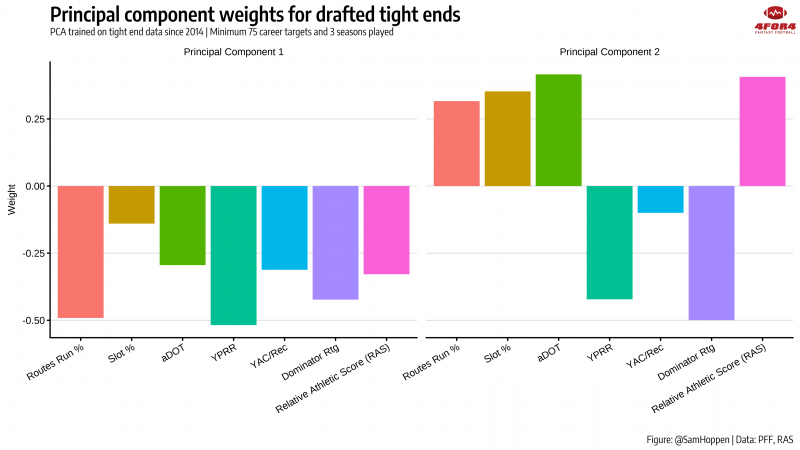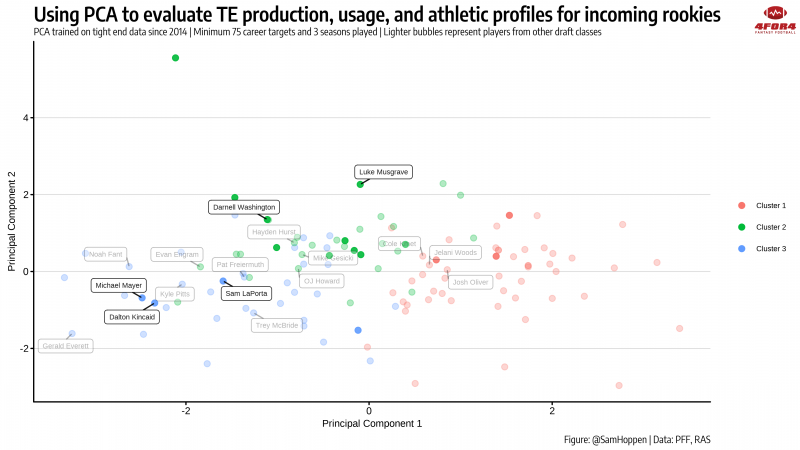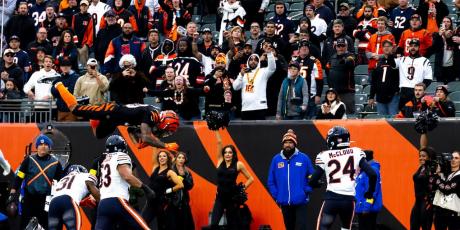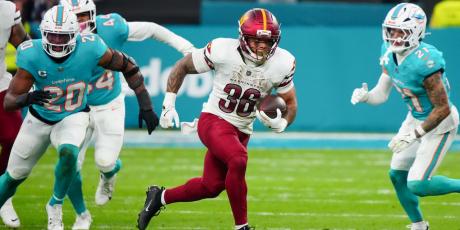NFL Draft Prospect Comparisons: Tight End

With the NFL combine now behind us, we have another piece of the puzzle filled in for prospect evaluations. While not every prospect participated in drills (or even attended the combine), those who did provided us with some valuable information. There were some players whose stock rose over the weekend while some players may have wished they didn't go to Indianapolis.
But, with this new data comes a new analysis. Last year, I wrote about college prospect profiles using only combine results, but this year I wanted to expand on that and get a more complete picture of who these players are. To do this, I use a technique called clustering, which allows me to bucket these players into a number of statistical profiles and compare them to one another. In the clustering, I included a combination of production, efficiency, athleticism, and usage metrics in hopes of capturing who these players really are.
More NFL Draft and Rookie Content: Scott Smith's 2023 Mock Draft Version 1.0 | 11 Players Who Turned Heads at the NFL Combine | 10 Fantasy Relevant Rookies: A First Look | Connor Allen's 2023 NFL Mock Draft 1.0 | NFL Draft Prospect Comparisons: Running Back | NFL Draft Prospect Comparisons: Wide Receiver |
This article will cover both the methodology that I used along with commentary on some of the standout players from the 2023 class. Draft season is in full swing!
Note: all college stats are for a player's full career in school.
Methodology
Before I get into the analysis, I want to explain the methodology and techniques that I used along with delineating what this analysis is and, more importantly, what it is not. Let's start off with the latter.
This analysis is a descriptive way to compare a player's college stats and athleticism to historical results. This is not a predictive indicator of future NFL and fantasy success or that a player with a similar combine result will have the same career.
In terms of the methodology, I used a Principal Component Analysis (PCA) using data since 2014. If you're unfamiliar with PCA, it is a way to "squish" several variables (in this case, each of our combine metrics), into just a couple of variables - our principal components - thus simplifying our dataset and reducing noise. Put another way, PCA helps us find fewer features that will represent our data in a more compressed way.
This also allows me to visualize the results on two axes using the first two principal components, which I wouldn't be able to do easily with the several combine metrics that we have. This is also where we'll be able to see player comparisons - players that appear further away from the center of the chart are more unique in their results and fall into a more distinct category.
For tight ends, below are the weights for the combine metrics for each of the two principal components. To calculate a player's principal component, you can read these as linear equations. So for principal component one, a player's score is calculated as (-0.49*Routes Run %) + (-0.14*Slot %) + (-0.29*aDOT) + (-0.52*YPRR) + (-0.31*Yards After Catch/Rec) + (-0.42*Dominator Rtg) + (0.32*Relative Athletic Score).

2023 Tight End Class Standouts
The 2023 tight end class is expected to be historic in terms of draft capital spent. It's also historic in another way: athleticism. There are three TEs this year - Zack Kuntz, Luke Musgrave, and Darnell Washington - that rank in the top 12 in Raw Athletic Score (RAS) all-time and have a RAS of at least 9.9.
Obviously, one of the key aspects around tight end play that's missing from this analysis is blocking. Not only is that data very difficult to obtain (and quantify), but it also has become slightly less relevant as the tight end position has evolved with elite tight ends splitting out wide more often.
The chart below highlights some players for this year's rookie class (that I will further discuss) along with tight ends drafted in the top 75 that were included in my sample.

Dalton Kincaid (Utah)
It should be noted that Dalton Kincaid did not participate in drills at the combine due to a late-season injury. Utah's pro day is in a couple of weeks, so I wouldn't expect him to test then either. Still, Kincaid was an incredible receiving threat as a tight end. Kincaid averaged an exceptional 2.21 yards per route run in his career, which was the seventh-highest of the 118 tight ends in my sample. Over the last two seasons, Kincaid's 92.5 PFF grade was also the best among all tight ends.
As I mentioned, the role of a tight end is changing and Kincaid fits that. He was lined up outside or in the slot on 37% of his snaps throughout college and that rate jumped to 44% in his final season. Kincaid may be used more as a receiver than others because he's not particularly big. Many have said he's the best receiving threat tight end in this class, and I would have trouble disagreeing.
Comparable cluster profiles: Isaiah Likely
Michael Mayer (Notre Dame)
Recently, Michael Meyer became tied with Kincaid as the betting favorite to be the first tight end selected in this April's draft. Mayer may be as good of a receiving threat as Kincaid, and he was definitely the more productive one. Mayer cleared 800 receiving yards in both his sophomore and junior seasons. His 92.5 PFF grade in 2022 also led the nation with his 82.1 run-blocking grade ranking fifth in the nation - he's as well-rounded as they come.
Mayer isn't going to be a burner (he ran a 4.70 40-yard dash) and may be closest to your historical prototypical tight end build. That doesn't mean he doesn't have what it takes to make moves with the ball in space. He'll be a trustworthy and a reliable outlet for any quarterback, as he's shown over the past several years. He may not be the sexiest prospect, but his floor may be the highest of this entire group.
Comparable cluster profiles: Jonnu Smith
Luke Musgrave (Oregon State)
With a 4.61-second 40-yard dash, a 36-inch vertical, and combined with his 6'6" and 523-pound stature, Luke Musgrave recorded a 9.94 Relative Athletic Score. This RAS ranks seventh out of 1,020 tight ends measured in this score since 1987. That is, perhaps, the only thing going for Musgrave at this point, because he didn't have much production in college.
Across four seasons at Oregon State, Musgrave totaled just 50 receptions for 638 receiving yards and two touchdowns (all of those marks are less than Mayer's final season at Notre Dame). Part of that is due to a COVID-shortened season in 2020 and an MCL injury last year, but even in his most productive season (2021) he only had 308 receiving yards and 1.23 yards per route run. For whatever it's worth, Musgrave did have a career average depth of target of 12.5 yards (third most in my sample). On top of that, though, was a 15.5% drop rate - I've said before that drop rates aren't that stable, but at this end of the extreme it is definitely not great to see.
Comparable cluster profiles: Mike Gesicki
Sam LaPorta (Iowa)
Sam LaPorta is the latest in a long line of great tight end prospects to come from Iowa (do T.J. Hockenson, Noah Fant, and George Kittle ring any bells?). LaPorta was a massive part of Iowa's passing attack while he was there. Per Rich Hribar, LaPorta accounted for 30.4% of the Iowa receptions (second in this class), 28.1% of the target (second), and 32.0% of the receiving yards (first).
Biggest Combine winners by position (imo):
QB: duh
RB: Zach Cahrbonnet, UCLA
TE: Sam LaPorta, Iowa
OT: Blake Freeland, BYU
IOL: Cody Mauch, NDSU
DT: Adetomiwa Adebawore, Northwestern
DE: Lukas Van Ness, Iowa
LB: Jack Campbell, Iowa
CB: all of them
S: Quan Martin, Illinois— Mike Renner (@PFF_Mike) March 6, 2023
He only lined up from the slot or out wide on 24.8% of his snaps, and he also spent 8% of his snaps lined up in the backfield. Classic Iowa! LaPorta still has some refining to do, but having just turned 22 years old, he should have plenty of time to develop for a team that doesn't need immediate tight end production.
Comparable cluster profiles: Pat Freiermuth
Darnell Washington (Georgia)
At this point, most are familiar with the absolute unit that is Darnell Washington. If you aren't, just watch this video and you'll get an understanding of his athleticism. Washington stands tall (an understatement) at 6'7" and 270 pounds, but that's not all that he offers. It took until this past year for Washington to show his pass-catching skills, during which he averaged 15.8 yards per reception and a solid 1.77 yards per route run.
You may not think it because of his size, but Washington is also elite after the catch (probably because he's a monster that's impossible to tackle). He averaged 7.5 yards after catch per reception, which is the 12th-highest mark of all the tight ends in my analysis. It's also impressive because his average depth of target was in the top 10 of these players at 11.7 yards. Regardless of where Washington lands, I'm very excited to see him at the NFL level and hope that teams can use him in unique ways.
Comparable cluster profiles: Josiah Deguara (but actually, nobody compares to Washington - have you seen him???)























